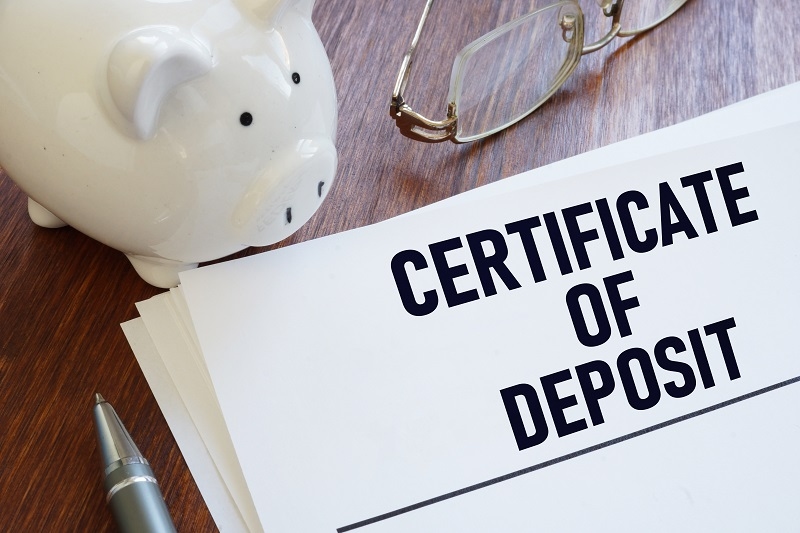
If you're looking for a low-risk method to build your savings with higher returns than a typical savings account, you may be asking yourself: What is a certificate of deposit, and is it worth investing in? With competitive fixed rates and a reputation for low-risk investments, CDs are one of the easiest financial products available. Knowing how CDs work in the US, how they are different from regular savings accounts, and how to find the best CD rates and terms can help you decide whether or not this is the right option for you.
A certificate of deposit (CD) is a time deposit offered by banks and credit unions. When you buy a CD, you are agreeing to keep your money locked up for a defined length of time — anywhere from several months to several years — in exchange for a promised interest rate. Unlike savings accounts, CDs have a maturity date. Take out the money before then, and you'll probably be charged an early withdrawal penalty.
CDs are insured up to $250,000 by the government through the FDIC (Federal Deposit Insurance Corporation) or the NCUA (National Credit Union Administration), which makes them among the safest savings options. That's part of the attraction, particularly for conservative investors.
A helpful way to understand how CDs (Certificates of Deposit) work in the U.S. is to define the important parts:
Financial institutions typically have different term lengths available, ranging from short-term (3 to 6 months) to longer-term (5 years and beyond). As a rule, the longer the term, the higher the interest rate. However, it also means their access to your cash will be more difficult during that time.
When it comes to CD versus savings account returns, the main difference is in the interest rate and liquidity. Savings accounts provide flexibility—you can get your money at any time. CDs provide fixed-rate CD investing that secures a rate for the term, irrespective of changing markets.
Break it down:
A Certificate of Deposit (CD) typically offers higher fixed interest rates than savings accounts, which have lower variable rates. With a CD, the funds must be held until maturity; however, funds in savings accounts are easily accessible. Many banks place higher minimum requirements and early withdrawal penalties with a CD compared to savings accounts, which usually have a low or no minimum and no penalties. In general, CDs are best for long-term savers, while savings accounts are best for short-term savings goals or emergency funds.
If you're looking to earn a greater return on idle funds and you won't need the money in the short run, CDs typically pay a better return than savings accounts.
Fixed-rate CD investment is perhaps the most attractive reason for investing in a certificate of deposit. With interest rates that remain fixed throughout the duration, CDs enable you to forecast your returns precisely. This proves especially useful in uncertain economic times when variable rates on savings accounts or money market funds tend to decrease.
For instance, when you purchase a 2-year CD with a 4.5% APY, that will remain the same rate even if the market falls. That level of certainty makes CDs popular with retirees, conservative investors, and those creating a diversified savings plan.
Some best practices for fixed-rate CD investing are:
One of the drawbacks of CDs is locking your money away. Still, you'll want to consider a strategy called CD laddering that allows you to keep flexibility in your savings but still access fixed rates.
Here's how it works:
CD laddering offers the best of both worlds - access to your money when you need it, and better long-term returns while protecting against interest rate fluctuations.
Not all CDs are created equal. To find the best CD terms and rates, shop around for bids from:
Factors to consider when comparing offers on CDs: Annual Percentage Yield (APY): The higher, the better.
You can check websites such as Bankrate or NerdWallet to compare live CD rates in various institutions. Some online banks offer "no-penalty CDs" that allow early withdrawals at no cost.

In addition to traditional CDs, you also have several options to consider depending on your financial situation:
1. Traditional CD - This is the standard product that refers to a fixed term and fixed interest rate, with penalties for early withdrawal.
2. No-Penalty CD - This allows you to opt to withdraw early without penalty, for a lower interest rate than traditional CDs would give you.
3. Bump-Up CD - This does allow you to bump up your interest rate, if and when market rates increase.
4. Jumbo CD - A type of CD that requires a higher total deposit (generally $100,000+) and has a higher APY.
5. IRA CD
This knowledge assists you in matching the appropriate CD type with your financial goals.
Now that you know what is a certificate of deposit, let's discuss who stands to gain the most from investing in CDs:
But if you want the cash quickly or anticipate higher interest rates, a CD may not be the ideal choice—at least, not without exploring no-penalty alternatives or laddering.
Interest you earn on CDs counts as taxable income, even if you don't touch the interest until the CD matures. For most, that will mean:
Always talk to a tax professional to know how CD returns impact your particular tax profile.
Although certificates of deposit are one of the safest investments, they're not flawless. Keep the following in mind before you sign up:
With that said, such risks tend to be minimal relative to the safety and reliability CDs provide.
In summary, what is a certificate of deposit? It's a safe, time-based savings instrument that provides reliable, frequently above-average interest rates—particularly relative to savings accounts.
If you have excess money and do not require ready access, CDs might be a suitable method to earn interest while preserving the safety of your investment. Employ techniques such as CD laddering, monitor rates regularly, and think about your long-term financial needs to maximize fixed-rate CD investing.
This content was created by AI